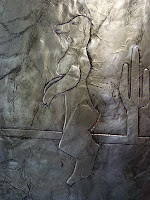Lorenzo Ghiberti condensed the Old Testament into ten panels to produce one of the defining masterpieces of the Italian Renaissance known as the "Gates of Paradise" (termed by Michelangelo). These are located in Florence, Italy.
Student work:
The students first worked on collagraph prints. We used donated poster board (it came in rolls) that we cut into shapes and layered. They had to have multiple pieces. We used Elmer's glue (it holds better) to adhere the pieces together. They had to first create rubbings using the sides of crayons. They had to create 5. I told them how to label their creations (we use a pencil, write small, sign their name, etc.) to get them away from scribbling their name in large letters using a marker or sharpie! It's devastating to see a beautiful artwork destroyed by a student scribbling their name across it. They then had to paint a layer of acrylic paint and create a mono print. Being that we're in the real world, and my examples were old, these materials didn't work. They pulled the layers of poster board up... So, we decided to create aluminum foil creations!
The results were spectacular.
After creating the collagraph prints (layered poster board), we either added a thin layer of glue or a thin layer of paint on top of the poster board. The students placed the poster board face down on the shiny side of a piece of aluminum foil. They flipped them over (not folding the edges yet). They used their finger and thumbs to press the foil into the layers very carefully. Some used a ball point pen and went around the edges or made texture. They painted a layer of India Ink on top of the foil and used balls of paper towels to rub in circles, rubbing the majority of the ink off. If it dried to quickly, they could damped the paper towel and keep rubbing. They then folded the edges back and glued the back (some taped) and then wrote their names on the back. Fabulous results!













No comments:
Post a Comment